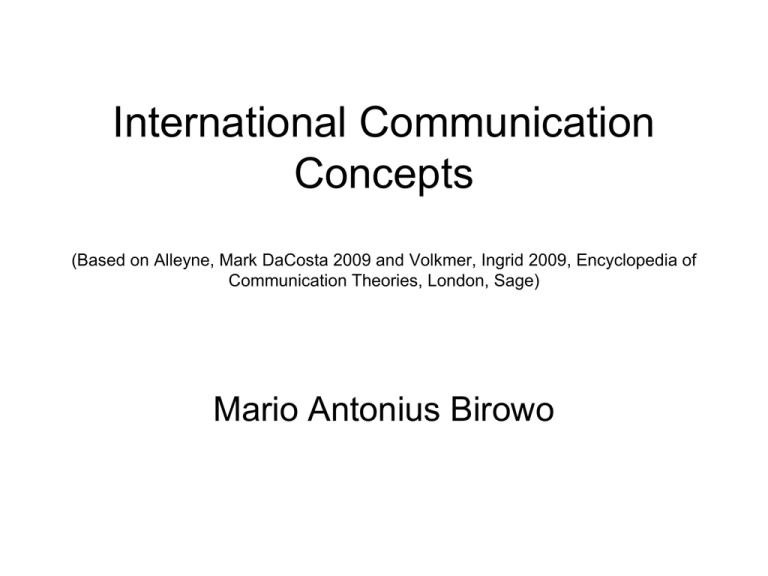International Communication Concepts
advertisement

International Communication Concepts (Based on Alleyne, Mark DaCosta 2009 and Volkmer, Ingrid 2009, Encyclopedia of Communication Theories, London, Sage) Mario Antonius Birowo Komunikasi Internasional • International? – Apa artinya? • Komunikasi? – Apa artinya? • Komunikasi Internasional? International communication is the name given to a field of inquiry that includes the study of various forms of interaction globally, including global communication via mass media, cross-cultural communication, and telecommunications policy. To understand global communicative relationships, international communication place varying degrees of emphasis on three elements: 1. actors 2. technology 3. modes of production Actors • The international is an arena dominated by states that are the primary sources of agency. • Therefore, theories of international communication in these paradigms are essentially theories of how states interact with each other The states are the only actors with the legitimacy to create the domestic and international laws that control the behavior of these other actors. Technology • The revolution in communication technology of the late 19th and the 20th centuries is the single most powerful factor. • It focuses on the quest to understand the impact of new communication technologies on international relations (i.e: internet). Modes of Production • The economic systems that produce goods and services, provide employment, configure trading relationships, and produce patterns of wealth creation and investment have been the third major element in international communication theory building. • International communication reflects economic relationships, for example, the tendency of news flows to mirror patterns of global trade. • The first theory of “international communication” was developed in the late 1950s. This approach aimed to utilize communication for the modernization of developing countries. • Daniel Lerner development communication. – The use of media as drivers of the transformation of “traditional” societies, meaning developing countries. – Lerner's 1958 “The Passing of Traditional Society” modernization processes in various Middle East countries, such as Turkey, Lebanon, Egypt, and Syria • The early satellite age: Intelsat (1960) moon landing of Apollo 11 in 1969 • The second phase of satellite communication throughout the 1980s and 1990s CNN, MTV Five Paradigms • theories of internationalism, • the Marxist paradigm of international communication, • theories of representation, • reception theories, • theories of identity. Theories of Internationalism • Technologically deterministic – the more interconnected the international system becomes via the new technologies, the more democratic and peaceful the world will be • Theories of internationalism popular early in the 20th century – Race differences – Modernization The Marxist Paradigm of International Communication • • • • The modes of economic production Class struggle 1960s Dependency and the power imbalance between core and periphery countries • International mass communication was dominated by transnational capitalist interests, especially corporations. Theories of Representation • Theories of representation are interpretive schemes that provide tools for understanding tendencies in international communication, especially unequal international communication relationships. • There is a constant struggle to maintain dominant ideologies Theories of Reception • Theories of reception argue that international media flows are unequal • To explain the phenomenal popularity of American audiovisual productions around the world U.S. movies and television shows are transparent texts because they can be easily decoded by people from different cultures. • NWICO (the United Nations for a New World Information and Communication Order ) Theories of Identity • It does not necessarily assume the primacy of nation-states – element of actors • The era of networks Globalization • Silk Road • Printing press






